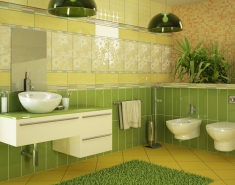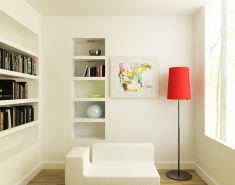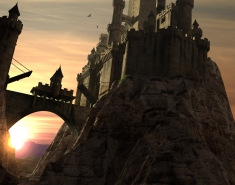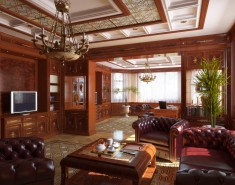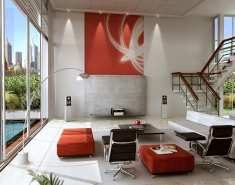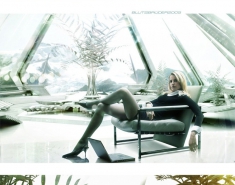Jeff Stikeman Architectural Art, Arch Viz As Concept Design Tool Article by Marsha Carlson Jeff Stikeman has been a practicing architect for over twenty years and speaks the language of architectural visualization well, moving fluently between traditional and digital media. His is a unique combination of CG and traditional picture production methods using MAXON’s CINEMA 4D for his 3D application. For Stikeman, C4D has been an excellent fit with its interface, rendering speed and remarkable stability. Yet he doesn’t necessarily use C4D the way the developers intended. His process keeps him in control, not the software.  Screen Shot St. Demetrios Greek Orthodox Church Boston Stikeman’s First Project Using MAXON’s CINEMA 4D Architectural visualizers like Stikeman step into a development process that is often contradictory, chaotic and conflict laden. His place in the design process comes at a critical time, often before a financial deal is made while design elements are still not defined and when ideas are just being discussed. A visualization at the early stages of a design process can galvanize thinking and bring people together. Architects preside over such discussions because of the skills they have developed to get clarity when thinking has gone fuzzy. This happens by the simple act of creating external visualizations of what has been an internal thought process.  St. Demetrios Greek Orthodox Church Boston by Jeff Stikeman, CBT Architects Rendered Using Non Photoreal (NPR) Techniques Recently there has been an expansion of interest in visualization techniques that can be more quickly created and at the same time convey the purpose of a project to stakeholders at many levels and carry multiple meanings.  Details St Demetrios Church Architectural visualization is often described in one of two ways; either photoreal or non-photoreal (NPR). Photorealism is a name given for a style of art that aimed to make paintings look like a photograph. In CG, the name has the same meaning; images that are made to look like photographs. Non-photo real images, rather than striving for a photoreal effect, have a communicative and expressive purpose. Research is showing that NPR images offer advantages over photographs in fields such as medicine, architecture, entertainment, education, geography and publishing. Architects are, for example designing graphics displays in operating rooms so doctors can read complex data as an image with just a glance. There is a concept in visualization to be remembered. We are looking through the rendering to the reality beyond. As Stikeman says “We remember what a brick looks like with a mere suggestion in a more complete way than if it were photographically rendered.” There is a difference between the way things exist and they way they appear. Taking an NPR approach to architectural visualization recognizes this fact.  Northfield Mount Herman School for CBT Architects Boston Stikeman Combined his C4D Model with Traditonal Watercolor For example scale is one of the most dominant design principles in architecture and yet it is not always accomplished by measurement. As Stikeman describes it: “The physical model of a project site with its building placed in context often shocks designers because an existing building doesn’t quite jive with their memory of it. Once you start measuring something you have tainted it. Once you try to figure out how far away a context building is and you put a scale down and say ‘oh really, that’s 200 feet away. I should really pay attention to that. Well If it didn’t feel like 200 feet then it isn’t 200 feet. The memory, the experiencing of it is more important than the reality of it.  Screen Shot in CINEMA 4D of Northfield Mount Herman School At the early stages, the image isn’t necessarily for marketing. As Stikeman says, “We need everybody to feel this project is real, that the project can happen. That to me is a different kind of reality than photoreal. Laying bare every design detail, every doorknob, that is tiring for the viewer, and it doesn’t leave them with a emotional response. I try to warn clients not to get hung up on showing every bit of genius.  Details Northfield Mount Herman School Researchers, Strothotte and Schlechtweg’s highly recommended book, Non-Photorealistic Computer Graphics: Modeling, Rendering and Animation reflects Stikeman’s approach. According to the authors: “A quick sketch needs to look hasty to signify that the idea is fresh from the mind. A polished rendering gives a sense of finality which can be misleading or even frightening in some situations where an immediate solution has not been sought. The “sketched” look is instantly recognized as being an indication of intent with room for change and possible errors. Stikeman Develops as a CG Architect at CBT/Childs Bertman Tseckares, Boston Jeff Stikeman’s development as a CG architect came at CBT/Childs Bertman Tseckares Inc in Boston where he was a senior architectural designer at the 200 person firm. His images then functioned as design documents. At CBT, Stikeman didn’t have time to light, model and render everything to photoreal standards, although when he first started with CG that is what he thought the tools were all about. As his skills evolved, Stikeman moved toward non photoreal quite naturally. He found himself deleting the textures and channels from the architects drawings, despite the continuing evolution of hatch patterns in CAD. Says Stikeman: “I would build up the surface my own way. I don’t try to put the world’s most perfect brick texture on a building and render it out. I usually find that details and too much reality in one little piece tend to draw the eye and create a distraction. People remember what brick is, better than what brick looks like." CINEMA 4D On A Plane Stikeman looked for an application that could handle high poly count scenes without bogging down his bare-bones mobile processor which is why he values CINEMA 4D. Says Stikeman, “C4D’s editor display rarely taxes my video card, even with poly counts in the millions, as when I import some else’s scorchingly triangulated mesh.” He needed to be able to tuck his office under his arm and get to the airport. C4D runs just fine on a plane. Add snakes as desired. Says Stikeman: “Using a 3D software program the way I do is like using a Formula 1 car to go get a gallon of milk. If I wanted to chase reality with Advanced Render I could, I could drive C4D as fast as I want to go." Software As Learning Device Jeff Stikeman uses his CG toolkit in his own unique way. What’s particularly interesting is that he found that working with CINEMA 4D has helped him to understand traditional media as well. For a project for Robert A.M. Stern Architects, Stikeman was on a very short deadline. Images were needed for a fundraiser for a new building at Miami University in Ohio, widely considered one of America’s most beautiful campuses. When he saw the way the space was lit, with multiple light sources, including a skylight, he did not think he could accomplish the job in the five hours he had. Then he saw that the columns were fluted too. What to do?  Farmer School of Business, Miami University for Robert A.M. Stern Architects His previous experience lighting a scene in CINEMA 4D had allowed him to understand how that space might be lit from above and allowed him to dive in and light it by hand. Says Stikeman: “I didn't do an actual radiosity/ambient occlusion render to get the info. I made a first 'underpaint' pass in pencil which was analogous to an ambient occlusion pass. In essence, I said 'what would a radiosity rendering of this space look like?" The excitement on the forums about the then relatively new ambient occlusion capability were an inspiration for Stikeman’s approach. “I think before C4D I’d have had shadows everywhere radiating from the skylight. But now I understood it was a diffuse source, and that there’d be a lot of even higher key lighting. The Psychology Of An Image Stikeman became aware of the psychology of an image and that the same design presented one way or another can make a big difference to a client. Researchers in NPR are very aware of this also and are discovering that an understanding of human psychology is essential to their quest to write the script to create images that move the emotions.  The Psychology of an Image 888 Boylston Street, Boston for Boston Properties .  Screen Shot 888 Boylston Street in CINEMA 4D  Details 888 Boylston Street The question Stikeman continually asks is “ How can we make an image, which has a life in a slide show of about 15 seconds, convey to their client what it is that is critical and masterful about a concept. If I can do that, I will have done my job.” Boston Architectural College Stikeman attended the Boston Architectural College where admission is open to anyone who applies. Students work in paid positions in design firms during the day and take courses in the evening. Faculty are working professionals who often volunteer their time. BAC is an example of workforce education where contextualized learning experiences have been found to be so highly motivating to students that training goals are accomplished in a shorter period of time. In recognition of this, graduates of BAC are able to sit for the professional licensing exam in architecture when they complete their studies. Their internship is concurrent with their education. This style of education comes at a cost. Sleep is the price. Motivation then is a very strong factor in being successful at BAC. With no particular design theory promoted, students learn to think for themselves and to be self governing. Stikeman talks about the experience helping him to understand that being the ‘creative’ on a project doesn’t make you the knight in shining armor. Rather he learned to be part of an orchestra, not a one man show. Stikeman’s Studio Equipment Jeff Stikeman’s studio is less than a year old and still in formation. He is currently running a Dell Precision M70, MS WindowsXP, Intel Pentium M (Mobile) Processor 2.13GHz with 2 GB RAM and nVIDIA Quadro FX Go 1400. His most recent acquisition is Wacom’s Cintiq 21UX, which has literally doubled his productivity and he says ‘worth twice what I paid’. Stikeman uses an Intuos 2 Tablet for on-the-go. Proof printing is done on an Epson 2200. His scanner is a 12x17 Microtek 9800XL. His software:is CINEMA 4D R9.102 Studio Bundle with Sketch and Toon, BodyPaint 3D R2, Adobe PhotoshopCS2 9.0.2, Corel Painter IX and whatever else helps him get the job done. Upcoming Show For Stikeman Stikeman’s work will be again be appearing in this year’s juried show, of the American Society of Architectural Illustrators, “Architecture in Perspective 22 Exhibition” will open at the Art Institute of Pittsburgh on October 12, 2007. See http://www.asai.org/ for more information. Arch Viz: A Force Shaping Project Development In the world where real estate and technology meet, Jeff Stikeman is clearly a player. He understands that the constraints of profit and loss and the schedule have as much potential to determine the image as the artist and the designer. He sees his strength as being able to produce images of impact with little information and little time. As he often repeats, “Deadlines and changes are certain, but there’s always time to produce an image to move a project forward.” Architectural visualization is the lingua franca, or common language, for all the players on a project team; from owner to contractor to real estate agent. It has the capacity to bring people together. When looking at the beauty, style and ‘gee whiz’ of architectural visualilzation, which is very apparent, what is most important to consider is the purpose the image serves in the construction process. Last May, during a session on Building Information Modeling (BIM) at the AIA Convention in San Antonio, a presenter shared that subcontractors were going out to look at the watercolor rendering on the project sign to understand the design intent. The analytical models and complicated shop drawings did not communicate well enough for them. The subs wanted to see a picture and an artist’s image gave them what they needed to see. Rearchers in NPR claim that the goal of art is the same as the goal of the brain, to extract the essential. Jeff Stikeman would agree: “The dictionary contains every poem ever written. The trick is to take out all the extra words and leave the poem.” SIGGRAPH 07 Will Welcome NPAR Symposium In recognition of NPR’s growing importance, SIGGRAPH 07 will welcome the International Symposium on Non-Photorealistic Animation and Rendering (NPAR) August 4 – 5 in San Diego. The goal is to raise awareness of cutting edge NPAR research, rendering systems and techniques. Bruce Gooch author, of Non Photorealistic Rendering, will be presenting Highlights of NPAR, Tuesday, August 7 th at SIGGRAPH 07. For more about Jeff Stikeman, please visit http://www.jeffstikeman.com 스케치 앤 툰을 이용한 건축 조감도.. 내공이...호곡.. |
건축
2007.09.16 23:57
스케치 앤 툰을 이용한 건축 조감도..
조회 수 12601 추천 수 0 댓글 8
Who's 길동

우울함의 원천은 역시 통장잔고!
해외작품
world best works
-
Vray for C4D 인테리어 작품들
-
Vray for C4D 인테리어 이미지들
-
castillo
-
브이레이의 끝은어디인가??
-
Vray for C4D 로 테스트되는 이미지들 입니다.
-
스케치 앤 툰을 이용한 건축 조감도..
-
CINEMA 4D - 건축
-
최후의 만찬
-
Inerior
-
Dreamer...




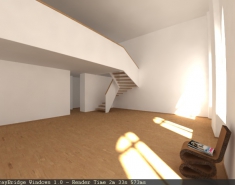 Vray for C4D 로 테스트되는 이미지들 입니다.
Vray for C4D 로 테스트되는 이미지들 입니다.
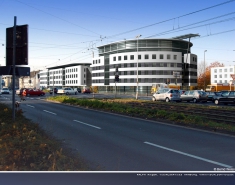 CINEMA 4D - 건축
CINEMA 4D - 건축



